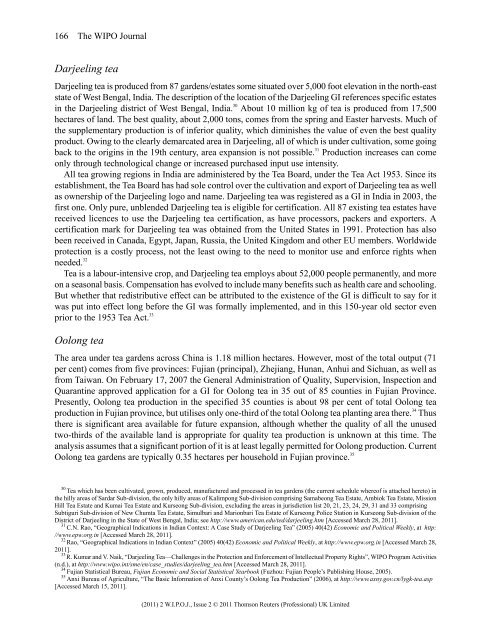WIPO Journal - World Intellectual Property Organization
WIPO Journal - World Intellectual Property Organization
WIPO Journal - World Intellectual Property Organization
Create successful ePaper yourself
Turn your PDF publications into a flip-book with our unique Google optimized e-Paper software.
166 The <strong>WIPO</strong> <strong>Journal</strong><br />
Darjeeling tea<br />
Darjeeling tea is produced from 87 gardens/estates some situated over 5,000 foot elevation in the north-east<br />
state of West Bengal, India. The description of the location of the Darjeeling GI references specific estates<br />
in the Darjeeling district of West Bengal, India. 30 About 10 million kg of tea is produced from 17,500<br />
hectares of land. The best quality, about 2,000 tons, comes from the spring and Easter harvests. Much of<br />
the supplementary production is of inferior quality, which diminishes the value of even the best quality<br />
product. Owing to the clearly demarcated area in Darjeeling, all of which is under cultivation, some going<br />
back to the origins in the 19th century, area expansion is not possible. 31 Production increases can come<br />
only through technological change or increased purchased input use intensity.<br />
All tea growing regions in India are administered by the Tea Board, under the Tea Act 1953. Since its<br />
establishment, the Tea Board has had sole control over the cultivation and export of Darjeeling tea as well<br />
as ownership of the Darjeeling logo and name. Darjeeling tea was registered as a GI in India in 2003, the<br />
first one. Only pure, unblended Darjeeling tea is eligible for certification. All 87 existing tea estates have<br />
received licences to use the Darjeeling tea certification, as have processors, packers and exporters. A<br />
certification mark for Darjeeling tea was obtained from the United States in 1991. Protection has also<br />
been received in Canada, Egypt, Japan, Russia, the United Kingdom and other EU members. <strong>World</strong>wide<br />
protection is a costly process, not the least owing to the need to monitor use and enforce rights when<br />
needed. 32<br />
Tea is a labour-intensive crop, and Darjeeling tea employs about 52,000 people permanently, and more<br />
on a seasonal basis. Compensation has evolved to include many benefits such as health care and schooling.<br />
But whether that redistributive effect can be attributed to the existence of the GI is difficult to say for it<br />
was put into effect long before the GI was formally implemented, and in this 150-year old sector even<br />
prior to the 1953 Tea Act. 33<br />
Oolong tea<br />
The area under tea gardens across China is 1.18 million hectares. However, most of the total output (71<br />
per cent) comes from five provinces: Fujian (principal), Zhejiang, Hunan, Anhui and Sichuan, as well as<br />
from Taiwan. On February 17, 2007 the General Administration of Quality, Supervision, Inspection and<br />
Quarantine approved application for a GI for Oolong tea in 35 out of 85 counties in Fujian Province.<br />
Presently, Oolong tea production in the specified 35 counties is about 98 per cent of total Oolong tea<br />
production in Fujian province, but utilises only one-third of the total Oolong tea planting area there. 34 Thus<br />
there is significant area available for future expansion, although whether the quality of all the unused<br />
two-thirds of the available land is appropriate for quality tea production is unknown at this time. The<br />
analysis assumes that a significant portion of it is at least legally permitted for Oolong production. Current<br />
Oolong tea gardens are typically 0.35 hectares per household in Fujian province. 35<br />
30 Tea which has been cultivated, grown, produced, manufactured and processed in tea gardens (the current schedule whereof is attached hereto) in<br />
the hilly areas of Sardar Sub-division, the only hilly areas of Kalimpong Sub-division comprising Samabeong Tea Estate, Ambiok Tea Estate, Mission<br />
Hill Tea Estate and Kumai Tea Estate and Kurseong Sub-division, excluding the areas in jurisdiction list 20, 21, 23, 24, 29, 31 and 33 comprising<br />
Subtiguri Sub-division of New Chumta Tea Estate, Simulbari and Marionbari Tea Estate of Kurseong Police Station in Kurseong Sub-division of the<br />
District of Darjeeling in the State of West Bengal, India; see http://www.american.edu/ted/darjeeling.htm [Accessed March 28, 2011].<br />
31 C.N. Rao, “Geographical Indications in Indian Context: A Case Study of Darjeeling Tea” (2005) 40(42) Economic and Political Weekly, at http:<br />
//www.epw.org.in [Accessed March 28, 2011].<br />
32 Rao, “Geographical Indications in Indian Context” (2005) 40(42) Economic and Political Weekly, at http://www.epw.org.in [Accessed March 28,<br />
2011].<br />
33 R. Kumar and V. Naik, “Darjeeling Tea—Challenges in the Protection and Enforcement of <strong>Intellectual</strong> <strong>Property</strong> Rights”, <strong>WIPO</strong> Program Activities<br />
(n.d.), at http://www.wipo.int/sme/en/case_studies/darjeeling_tea.htm [Accessed March 28, 2011].<br />
34 Fujian Statistical Bureau, Fujian Economic and Social Statistical Yearbook (Fuzhou: Fujian People’s Publishing House, 2005).<br />
35 Anxi Bureau of Agriculture, “The Basic Information of Anxi County’s Oolong Tea Production” (2006), at http://www.axny.gov.cn/lygk-tea.asp<br />
[Accessed March 15, 2011].<br />
(2011) 2 W.I.P.O.J., Issue 2 © 2011 Thomson Reuters (Professional) UK Limited

















